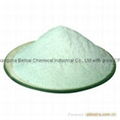| Model: | 99% |
|---|---|
| Brand: | BeiHai |
| Origin: | Made In China |
| Category: | Chemicals / High Polymers |
| Label: | Mechanical propertie , Thermal properties , Electrical propertie |
| Price: |
¥10500
/ t
|
| Min. Order: | 1 t |
Product Description
Mechanical properties
PVC has high hardness and mechanical properties. The mechanical properties enhance with the molecular weight increasing, but decrease with the temperature increasing. The mechanical properties of rigid PVC (uPVC) is very good, the elastic modulus can reach to 1500-3,000 MPa. The soft PVC (Flexible PVC) elastic is 1 point 5-15 MPa. However, elongation at break is up to 200% -450%. PVC friction is ordinary, the static friction factor is 0 point 4-0 point 5, the dynamic friction factor is 0 point 23.
Thermal properties
The heat stability of PVC is very poor, when the temperature reaches 140 °C PVC starts to decompose. Its melting temperature is 160 °C. The linear expansion coefficient of the PVC is small and has flame retardancy, the oxidation index is up to 45 or more. Therefore, the addition of a heat stabilizer during the process is necessary in order to ensure the product's properties.
Electrical properties
PVC is a polymer with good insulation properties but because of its higher polar nature the electrical insulating property is inferior to non polar polymers such as polyethylene and polypropylene.
As the dielectric constant, dielectric loss tangent value and volume resistivity are high, the corona resistance is not very good, it is generally suitable for medium or low voltage and low frequency insulation materials.
Applications
PVC's relatively low cost, biological and chemical resistance and workability have resulted in it being used for a wide variety of applications. It is used for sewerage pipes and other pipe applications where cost or vulnerability to corrosion limit the use of metal. With the addition of impact modifiers and stabilizers, it has become a popular material for window and door frames. By adding plasticizers, it can become flexible enough to be used in cabling applications as a wire insulator. It has been used in many other applications.
Pipes
Roughly half of the world's polyvinyl chloride resin manufactured annually is used for producing pipes for municipal and industrial applications.[15] In the water distribution market it accounts for 66% of the market in the US, and in sanitary sewer pipe applications, it accounts for 75%.[16] Its light weight and low cost make it attractive. However, it must be carefully installed and bedded to ensure longitudinal cracking and overbelling does not occur. Additionally, PVC pipes can be fused together using various solvent cements, or heat-fused (butt-fusion process, similar to joining HDPE pipe), creating permanent joints that are virtually impervious to leakage.
In February, 2007 the California Building Standards Code was updated to approve the use of chlorinated polyvinyl chloride (CPVC) pipe for use in residential water supply piping systems. CPVC has been a nationally accepted material in the US since 1982; California, however, has permitted only limited use since 2001. The Department of Housing and Community Development prepared and certified an environmental impact statement resulting in a recommendation that the Commission adopt and approve the use of CPVC. The Commission's vote was unanimous and CPVC has been placed in the 2007 California Plumbing Code.
In the United States and Canada, PVC pipes account for the largest majority of pipe materials used in buried municipal applications for drinking water distribution and wastewater mains.[17] Buried PVC pipes in both water and sanitary sewer applications that are 4 inches (100 mm) in diameter and larger are typically joined by means of a gasket-sealed joint. The most common type of gasket utilized in North America is a metal reinforced elastomer, commonly referred to as a Reiber sealing system.[18]
Electric cables
PVC is commonly used as the insulation on electrical cables; PVC used for this purpose needs to be plasticized.
In a fire, PVC-coated wires can form HCl fumes; the chlorine serves to scavenge free radicals and is the source of the material's fire retardance. While HCl fumes can also pose a health hazard in their own right, HCl dissolves in moisture and breaks down onto surfaces, particularly in areas where the air is cool enough to breathe, and is not available for inhalation.[19] Frequently in applications where smoke is a major hazard (notably in tunnels and communal areas) PVC-free cable insulation is preferred, such as low smoke zero halogen (LSZH) insulation.
| Payment Terms: | T/T;L/C at sight |
|---|---|
Member Information
| Changsha Beihai Chemical Industrial Co., Ltd. | |
|---|---|
| Country/Region: | Hu Nan - China |
| Business Nature: | Manufacturer |
| Phone: | 18874155620 |
| Contact: | Apple Ou (trader manager) |
| Last Online: | 16 Jan, 2014 |
Related Products of this Company
-
Titanium dioxide
US $2380
-
Chlorinated paraffin wax
-
Chlorinated polyethylene (CPE135A)
-
Stearic acid
US $1112
-
Barium carbonate
US $1428
-
Chlorinated paraffin wax







